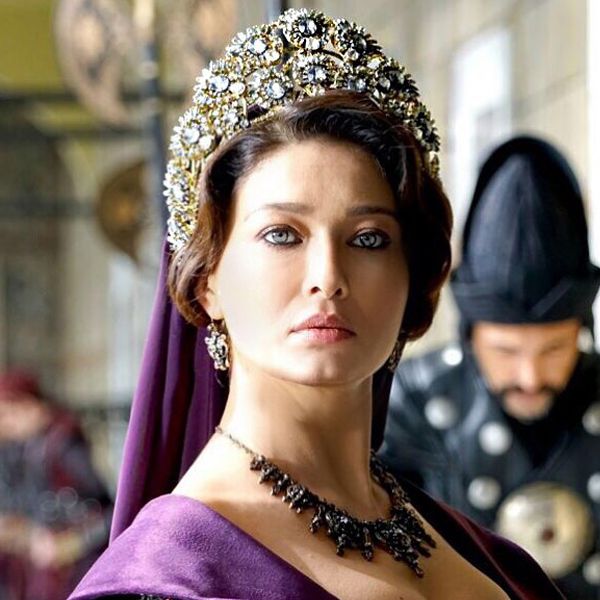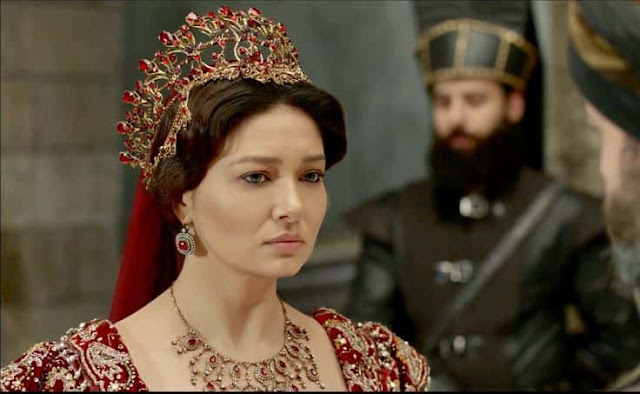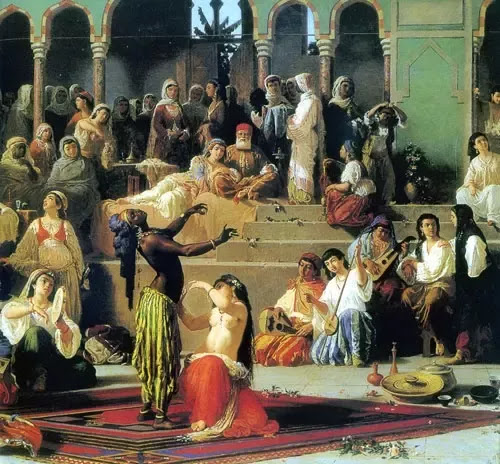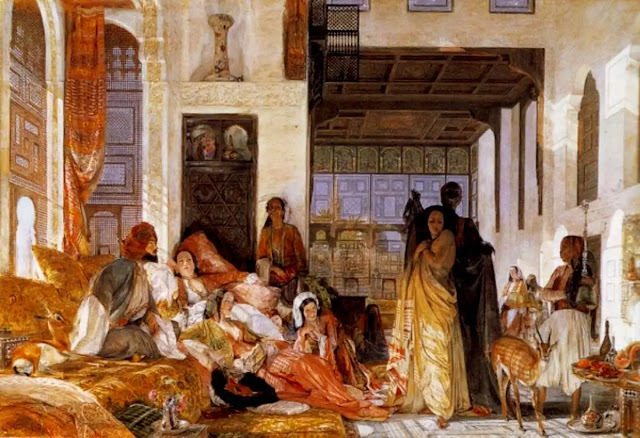Kösem Sultan (1589 1651), also known as Mahpeyker Sultan, was Haseki Sultan of the Ottoman Empire as the chief consort and legal wife of the Ottoman Sultan Ahmed I, valide sultan as the mother of sultans Murad IV and Ibrahim, valide sultan as the grandmother of Sultan Mehmed IV.
She oversaw 3
generations of the Ottoman Empire
Upon ascending to the
throne, the triumphant new Sultan would shout his first decree, usually
something like “All my brothers are to be immediately killed.”
Ahmed
built a wall to block the entrance, leaving a small window through which food
was passed to Mustafa, as well as alcohol and opium.
Fourteen years later, this same wall was hammered down, and the utterly demented Mustafa was declared sultan.
Background of Kösem Sultan
In 1604, at the age of 14 or 15, she was kidnapped by Ottoman raiders and bought as a slave in Bosnia by the beylerbey (governor-general) of the Bosnia Eyalet. She was tall, slender, and appealing woman due to the whiteness of her complexion and the deep brown of her eyes.
 |
| Kösem Sultan |
Her beauty and intelligence were noticed by the kızlar ağa of
Sultan Ahmed I's court, who sent her to Constantinople to join a group of other
slave girls marked by their striking appearance or intelligence to be trained
in the harem of Sultan Ahmed I as an imperial court lady.
Kösem rose to prominence early in Ahmed's reign as part of a series of changes to the hierarchy of the imperial harem.
 |
| Slave Market |
She was instrumental in putting an end to
the centuries-old practice of fratricide in the Ottoman Empire by convincing
Ahmed to spare his brother Mustafa.
Ahmed favoured Kösem above all his concubines, lavishing on her the finest jewels and a stipend of 1,000 aspers a day.
 |
| Slave Market |
During the reigns of Ahmed I, Mustafa I, Osman II, Murad IV,
Ibrahim and Mehmed IV, Kösem gained both notoriety and affection among her
subjects, wielding unparalleled political power and influencing the empire's
foreign and domestic policy.
On Ahmed's early death (1617), Kösem became
the head of a faction that successfully supported his half-brother Mustafa's
accession to the throne.
She probably feared for her sons' life, should their older half-brother, Osman, become sultan. She probably preferred to see Mustafa become sultan as he was less likely to see her sons as a threat.
In the Ottoman Empire,
the fratricide culture was at its peak at the time.
When Ahmed’s father Mehmed III ascended to
the throne, he executed all his nineteen brothers. In 1603, he also executed
his eldest living son Şehzade Mahmud, leaving only two of his sons, Ahmed I and
Mustafa I as his heirs.
 |
| Ottoman Sultan Ahmad I (Kösem Sultan was his queen) |
Ahmed ruled from 1603 to 1617, leaving
Kösem a young widow. Mustafa was released from the Cage, to become sultan,
while Kösem’s own sons, Murad, Beyazit, and Ibrahim, took his place there.
Reign of Mustafa I (Brother of Sultan Ahmad I)
Kösem, the widow of Ahmed I and mother of Murad IV was in league with the eunuch corp. Kösem and the eunuchs ruled through the mentally disabled Mustafa, while the Janissaries ruled through Osman II… whom they decided they didn’t like after all, and killed.
 |
| Mustafa I |
As
only the second sultan (after Ahmed I) to ascend the throne with no prior
experience of government, Mustafa proved feeble and incompetent.
He
had spent his entire early life in the harem, learning only what the eunuchs
and women could teach him, and constantly fearing execution at the hands of the
ruling sultans, with several palace officials, particularly the Chief Black
Eunuch Mustafa Ağa, nourishing these fears to control him.
Eventually, Mustafa Ağa spread stories that he was insane and secured his deposition on 26 February 1618, just 96 days after he ascended the throne.
He was replaced by Osman,
the eldest son of Ahmed I and his deceased mother Mahfiruz Hatun.
Reign of Osman II
Osman's first act as sultan was to take
power away from Mustafa's supporters, as well as those who had secured his
accession and planned to rule over him.
As a result, Kösem and her eight
children and entourage were banished to the Old Palace. Nevertheless, Kösem was
able to maintain her haseki status and daily stipend of 1,000 aspers during her
retirement.
While at the Old Palace, she had the opportunity to meet Safiye Sultan (grandmother of Sultans: Ahmed I and Mustafa I)
 |
| Osman II |
In
1619, Osman acted against Ottoman convention by paying Kösem a three-day visit
at the Old Palace and taking part in her festivities, thus showing his
particular affection for her.
He
also gave Kösem the income from eight villages to the north-west of Athens; she
then incorporated them into her waqf, which provided services to pilgrims traveling
from Damascus to Mecca.
His uncle Mustafa was kept alive, as were Osman's younger
brothers, protected by Kösem, who were at this time not old enough to pose a
threat to Osman's regime.
In May 1622, sensing that Osman might still
execute Mustafa and his younger brothers, the eunuch corps and the palace
soldiery planned a counter-strike, backed by Mustafa's mother, Halime Sultan,
and Kösem, who wanted her own children to ascend to the throne.
Storming into the harem, they freed
Mustafa from confinement in the Kafes.
As for Osman, aged only seventeen, he was imprisoned in
Yedikule, then strangled by members of the Janissary corps on 20 May 1622,
largely through the efforts of Halime.
Halime Sultan was a consort of Sultan Mehmed III, and the
mother of Sultan Mustafa I.
The first woman to be Valide Sultan twice. Halima lived in the Ottoman Empire as a courtier during the reign of six Sultans: Murad III, Mehmed III, Ahmed I, Mustafa I, Osman II, and Murad IV.
 |
| Halima Sultan |
Second reign of Mustafa I
In
place of Osman, the weak and incompetent Mustafa was restored to the throne
with the support of Kösem.
During
the closing months of Mustafa's second reign, he ordered the execution of
everyone involved in Osman's death, including Kösem's sons.
But before his orders could be carried out, both Kösem and the eunuch corps intervened and deposed him again.
Kösem
eventually reached an agreement with the viziers to install her son Murad as
sultan. Mustafa would go on to spend the rest of his life in the Kafes.
Kösem Sultan as Valide sultan: Reign of Ottoman Sultan Murad
IV
Murad IV was, son of Sultan Ahmed I and Kösem
Sultan.
He was brought to power by a
palace conspiracy when he was just 11 years old, and he succeeded his uncle
Mustafa I. Until he assumed absolute power on 18 May 1632, the empire was ruled
by his mother, Kösem Sultan, as nāʾib-i
salṭanat
(regent
The reign of Sultan Murad IV, known as the conqueror of Baghdad, is notable for halting the prevailing lawlessness and rebelliousness while restoring the authority of the state
Kösem entered the Topkapı Palace with a great ceremony which included having a thousand dervishes marching with prayers to celebrate her forthcoming.
 |
| Ottoman Sultan Murad IV |
She
was once again thrust into the political arena when her son ascended to the
throne in 1623 as Murad IV. Since he was a minor, she was appointed not only as
valide sultan but also as official regent
As regent, Kösem effectively ran the empire
through her son, Murad, attending and arranging divan (cabinet) sessions from
behind a curtain. She was in charge of appointing political figures and
overseeing the state's administration, which allowed her to establish
connections with statesmen, judges, and other court figures.
Called
Murad the Mad, though probably not to his face, the 17th sultan was just a lad
of 11 when he began his reign, although his mum did much of his homework as his
regent until he turned 20.
He used to hang around taverns at night in disguise, trying to
snare a drinker having a crafty smoke. Once the unsuspecting drinker lit up his
pipe, the sultan would suddenly reveal who he was and cut down the unlucky
smoker there and then by his own hand
After
catching a gardener and his wife puffing away, he had their legs cut off before
the pair were wheeled around the capital on the back of a cart, so the public
could watch them bleed out in agony.
He also didn’t like people getting too close to the palace
walls, personally shooting people that did so. It was the sultan’s prerogative
to take at least ten innocent lives per day, and he almost always did.
He once came across a group of women singing in a park and drowned them there and then because he didn’t like the din they were making.
His
musician played a Persian melody that upset him greatly so he cut his head off.
Having ordered the consumption of coffee to be illegal, he executed anyone who
drank it and even likewise for alcohol despite the fact that he was a raging
alcoholic himself.
A
group of singing women were drowned because they disturbed his peace and he
often forced the harem women to jump naked into a pool while he fired pellets
at their bodies.
Mad Murad’s reign did not last long, and he died at the
early age of 27 from cirrhosis of the liver.
Rumours had circulated that on his
deathbed, Murad IV ordered the execution of his mentally disabled brother,
Ibrahim (reigned 1640–48), which would have meant the end of the Ottoman line.
However, the order was not carried o
Reign of Mad Ibrahim: (The Mad Sultan on to
the throne).
After Murad’s death Kösem
promptly placed Ibrahim.Of Kösem's last surviving sons, the mentally unstable
Ibrahim, lived in fear of being the next of his brothers to be executed by
Murad.
Following Murad's death at the age of 27, Ibrahim was the sole surviving prince of the dynasty. When the Grand Vizier Mustafa Pasha asked him to assume the sultanate, Ibrahim suspected Murad was still alive and plotting to trap him.
It
took the combined persuasion of Kösem and the grand vizier to make him accept
the throne. For instance, Kösem ordered his brother's corpse to be displayed
before him and even threatened Ibrahim with 'strangulation, not inauguration'
if he refused to be crowned sultan.
With the accession of
Ibrahim, Kösem once again became politically active as his principal advisor.
However, she enjoyed a less compatible
relationship with the Grand Vizier Mustafa Pasha than she had with the grand
viziers of Murad's early reign.
Ibrahim
was in no shape to rule a nation. Odd to begin with, it didn’t help that he had
spent his entire life living as a prisoner in the golden cage, staring
longingly out the unreachable stained glass windows.
Inside the prince was kept company by a few deaf-mute servants, and a couple of harem girls, barren ones, to prevent him from fathering possible heirs to the throne. (The servants were, by default, prisoners as well.)
Ibrahim
also lived under the constant and reasonable fear of deaf-mute eunuchs
throttling him with a silk rope. So it makes sense that when guards showed up
to bring him to the throne, he refused to go, thinking it was a trick.
Ibrahim wouldn’t even open the door until Murad’s body was produced. When Ibrahim was finally convinced that he was not about to be garroted to death, he ran deliriously through the halls screaming “the butcher is dead”, “the butcher of the empire is dead.”
Suddenly out of the cage and the supreme ruler of an enormous
empire, Ibrahim barely knew what to do with himself. While his mom did most of
the actual decision making, Ibrahim busied himself with his new harem.
He first decorated his room with mirrors so that he might get a better view of himself in action. He then called the girls in.
One
time the Mad Sultan saw the beautiful daughter of the Grand Mufti, the empire’s
highest religious authority, and asked for her hand in marriage.
Her father, aware of Ibrahim’s depravities, urged his daughter to decline. So the Mad Sultan ordered her kidnapped and carried to his palace, where he ravished her for days, before returning her to her father.
Ibrahim’s
harem was full of young, nubile, girls from around the world. But after a
while, the slender things from Russia and the Balkans didn’t do it for him
anymore.
One day Ibrahim happened
to see the genitalia of a female cow.
Pleased by what he saw, Ibrahim had a
gold cast made and, hoping to find a human match to the bovine privates, he
ordered his aides to “bring him the fattest woman in the world.”
They did their best, finding a 300
pound Armenian girl named “Sugar Cube” (Sechir Para or more literally
translated “Sweet Lump of Sugar”).
Ibrahim loved her, and spent many a night
curled in her large arms. It wasn’t long until the big woman had gained power
over Ibrahim equal only to that of her girth.
It
would be Sugar Cube who would spell the final downfall of Ibrahim the Mad.
Sugar
Cube told Ibrahim that a member of his concubine was sleeping with an outsider
and conspiring against him. The paranoid Ibrahim, decided to clean house and
had the majority of his harem, some 280 girls, tied up in sacks and drowned in
the river.
This
worried his mother Kösem, who was actually ruling the foundering empire.
Concerned about Sugar Cube’s rising power, she in turn had Sugar Cube
strangled. The palace was indeed a rough place.
They knew her everywhere as “the Filthy Sultana.” One day one of her many enemies caught up with her and poisoned her coffee with chopped hair and ground glass, causing a long and painful death.”)

With
permission from Kösem, the Grand Mufti whose daughter Ibrahim had had his way
with, lead the overthrow.
Between
heavy taxes, the mismanaged wars, and with a Venetian blockade reducing the
Ottoman capital to starvation, discontent boiled over. In 1648, a popular
revolt broke out, and an angry mob tore Ibrahim’s Grand Vizier to pieces.
Ibrahim was deposed in
favor of his 6 year old son, and a fatwa was then issued for the Mad Sultan’s
execution, which was carried out by strangulation.
Ibrahim was deposed, sent back to the
golden cage, and 10 days later his worst fears were realized at the hands of a
deaf-mute eunuch wielding a silk rope. This time Ibrahim met his end gleefully,
assuming that the guards were there to replace him as Sultan.
Reign of Mehmed IV seven-year-old grandson of Kösem
On
the same day that Ibrahim was dethroned, Kösem presented her seven-year-old
grandson, Mehmed, to the divan with the words: "Here he is! See what you
can do with him!"
When some government official insisted that he be sent to be enthroned and receive the Janissaries' and sipahis' (cavalryman) oath of allegiance at the Blue Mosque, Kösem demanded that they instead come to the palace, pointing out that no sultan had ever been enthroned in a mosque before.
 |
| 7 year old Young Sultan Murad IV |
Her
purpose was undoubtedly in part to force the situation so that she could have
some influence over the outcome.
Murder of Mad Sultan Ibrahim
Ten days after Ibrahim's dethronement, the newly appointed Grand
Vizier Mehmed Pasha asked the Şeyhülislam Abdürrahim Efendi for a fatwā sanctioning
Ibrahim's execution which was granted, with the message: "If there are two
caliphs, kill one of them."
Kösem expressed the fact that only she could make the final decision whether the sultan lived or died, exclaiming: "They said my son Ibrahim was not suitable for the sultanate.
 |
| killing of Sultan Ibrahim |
I said 'depose him.' They said his presence
is harmful, I said 'let him be removed', and then I said 'let him be executed.'
If anyone is under my protection, it is my son."
"It
being an ancient custom that upon the accession of a new sultan the mother of
the previous sultan remove to the Old Palace and thus give up her honored
office, the elder valide requested permission to retire to a life of seclusion.
But
because the loving mother of the new sultan Mehmed IV was still young
and truly ignorant of the state of the world, it was thought that if she were
in control of government, there would result the possibility of harm to the
welfare of the state.
Therefore,
the elder valide was reappointed for a while longer to the duty of training and
guardianship, and it was considered appropriate to re-new the assignment of
crown lands to the valide sultan."
Thus Kösem was reinstated as regent by
Mehmed's council and was entrusted with his training and guardianship.
Rivalry with Turhan Sultan Mother of Mehmed IV
Mehmed's mother, Turhan Sultan, was presented to Kösem as a gift from Kör Süleyman Pasha, the Khan of Crimea, when she was around 12 years old, so it was presumably Kösem who offered Turhan to Ibrahim as a concubine.
 |
| Turhan Sultan (Mother of Sultan MEHMAD IV) |
The post of valide sultan and regent should
have gone to Turhan when her son Mehmed became sultan, but she was passed over
because of her youth and inexperience.
Turhan must also have resented the stipend
of 2000 as pers that she received in comparison with Kösem's 3000 aspers and so
she began to assert what she saw to be her rightful authority.
Assassination of Kosem Sultan
In a certain irony, Kösem’s reign would
finally come to an end at the hands of another woman. Her daughter-in-law and
Mehmed’s IV mother Turhan had Kösem killed and started her own rule of the
Ottoman Empire. (She was the only other woman besides Kösem to officially rule
the Ottoman Empire.)
On the 16th day of Ramadan, the night of 2
September 1651, the Chief Black Eunuch Süleyman Ağa and his armed men,
consisting of over 120 armed black and white eunuchs, descended on the palace
in support of the sultan, proceeded to Kösem's quarters, which was guarded by
over 300 armed Janissaries and loyal black eunuchs.
 |
| Murder of Kösem Sultan |
Süleyman
Ağa and his men managed to kill some of the guards, while the majority fled.
Hearing the commotion, Kösem thought the Janissaries had arrived, so she called
out, "Have they come?" "Yes, they have come", Süleyman Ağa
answered, hoping to deceive her.
When
Kösem recognised his voice, she began stuffing her jewels into her pockets and
fled along the Golden Way and through the Court of the Black Eunuchs to the
Dome with Closets, probably hoping to escape from the palace through the
Carriage Gate.
 |
| Black Eunuch |
The gate was locked, so
she crept into a small cabinet, hoping that Turhan's eunuchs would pass her by
and that the Janissaries would come to her rescue.
Eventually
Kösem was betrayed to a halberdier by a piece of her dress that protruded from
under the cabinet door. Dragged out by one of her assailants, she told him,
"O brave man, be not cruel unto me", while tossing gold coins onto
the floor as a distraction.
One
of the men then held her down, while they seized her garments, jewellery,
bracelets, garters and other valuables.
Kösem
was then dragged by her feet to the gateway leading from the harem into the
Third Court, where Süleyman Ağa ordered his men to kill her. A group of four
men, all of them young and inexperienced, then strangled her with a piece of
cord ripped from the curtains.
Then,
assuming she was dead, they screamed out, 'She is dead, she is dead!' and went
to notify the sultan and his mother.
 |
| Painting OF Kösem Sultan |
The next morning, Kösem's body was taken from Topkapı
Palace to the Old Palace (Eski Sarayı) to be washed.
The Black Eunuchs immediately took up the
Corpse, and in a reverent manner laid it stretched forth in the Royal Masjid;
which about 400 of the Queens Slaves encompassing round about with howlings and
lamentations, tearing the hair from their heads after their barbarous fashion,
moved compassion in all the Court."
She was buried without ceremony in the mausoleum of her late husband Ahmed I. Her slaves were also taken to the Old Palace and eventually married to suitable Muslims with dowry money taken from her estate.
 |
| Blue Masjid( Sultan Ahmad Masjid) Istanbul |
The End
Disclaimer–Blogger has
prepared this short write up with help of materials and images available on
net. Images on this blog are posted to make the text interesting.The materials
and images are the copy right of original writers. The copyright of these
materials are with the respective owners.Blogger is thankful to original
writers.











.jpg)



No comments:
Post a Comment